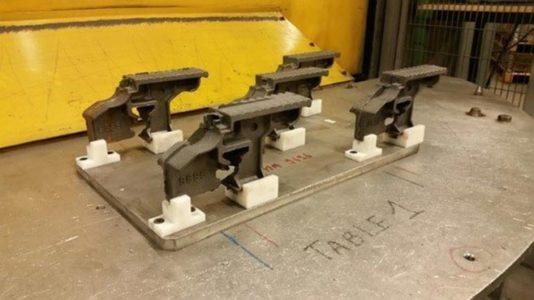 VHM Fonderie, a French foundry and machining company, has reduced its manufacturing and production speeds by up to 5 weeks with the Stratasys PolyJet 3D printing solutions. The company, which specializes in the production of industrial iron castings, uses the Stratasys Connex Multi-material 3D printer to optimize each process involved in the design and production phases.
VHM Fonderie, a French foundry and machining company, has reduced its manufacturing and production speeds by up to 5 weeks with the Stratasys PolyJet 3D printing solutions. The company, which specializes in the production of industrial iron castings, uses the Stratasys Connex Multi-material 3D printer to optimize each process involved in the design and production phases.
Traditional sand casting methods or production involves the creation of customized sand molds. Using a ladle, molten metal is poured into the sand mold until it is solidified. Once the final product is built into shape, the sand mold is then destroyed and for the manufacturer to create another object, a new sand mold has to be created. Thus, the necessity of a unique sand mold for the production of metal objects makes sand casting a low production rate-method of molding.

Products 3D printed with Connex3
Regardless of the time-consuming process, foundries and machining companies like VHM Fonderie still use sand casting for various advantages. Sand casting requires less capital as the mold is created from a cheap material, requires less skill for operators, uses affordable equipment and is applicable with large castings.
However, a few of the obvious disadvantages with sand casting are its poor surface finish resulting from sand indentation and inability to deal with mass production.
To solve both issues and cover the limitations of traditional sand casting, VHM Fonderie partnered with Stratasys to implement its 3D printing solutions. Over time, the French company observed significant improvement in both areas, as 3D printing technologies allowed the team to create more stable and detailed sand molds while saving an enormous amount of production time.
Laurent Poux, Industrial Director at the VHM Group, described the impact of 3D printing on its operations as “transformational,” considering the level of improvements 3D printing technology led to.
“To manufacture an object using the sand casting process, we need to first produce a master model of the specific part. This is then used to make a mold, from which the desired object itself is then manufactured. In the context of the end-to-end manufacturing workflow, the level of time-saving enjoyed with 3D printing isn’t merely improvement or progression – it’s transformational,” said Poux.
 On average, VHM Group partner Stratasys reported that the utilization of 3D printing reduced production time by nearly a month for the company, which allowed the firm to drastically increase production levels and accept more incoming production requests.
On average, VHM Group partner Stratasys reported that the utilization of 3D printing reduced production time by nearly a month for the company, which allowed the firm to drastically increase production levels and accept more incoming production requests.
More importantly, Stratasys also noted that the consumer satisfaction rate increased substantially as well, as customers began to receive deliveries of their final molded metal products at much faster times. Because the clientele of VHM Fonderie consists of high profile construction companies and flow management solutions providers, faster delivery times also save its clients the capital involved in their construction processes and alternative projects.
In most cases, companies rely on third party or service providers like Stratasys to serve and supplement each aspect of their operations. It is rare to see a company develop and launch its own 3D printing service department or center to maximize the potential of 3D printing.
After seeing the sheer amount of capital and time 3D printing solutions of Stratasys saved the company, VHM Fonderie established its own 3D printing service bureau called Reali3D. Poux stated that with the bureau in place, the company envisions to produce every product from concept models to fully functional prototypes in the near future.
“Use of Stratasys 3D printing technology has given us a level of self-reliance that has not only revolutionized some of our traditional production processes, but it has allowed us to become significantly more flexible as a company when it comes to manufacturing,” said Poux.
As large-scale corporations and conglomerates like VHM gain confidence in the implementation of 3D printing, the market for the 3D printing industry will significantly expand in the upcoming years. Furthermore, companies like VHM have already gained enough confidence to establish departments of their own to focus solely on the development and implementation of 3D printing technologies.
President of Stratasys EMEA Andy Middleton noted that VHM’s adoption of 3D printing is a perfect example of corporations coming to a realization of 3D printing’s potential and its vast applicability. Middleton and the rest of the Stratasys development team hope to see a similar kind of mainstream adoption of 3D printing in the short term in other industries as well.
“VHM Fonderie is the perfect example of how a growing number of manufacturers are not merely exploring the use of 3D printing in a limited capacity, but are reaping multiple benefits through its widespread integration across all areas of production,” said Middleton.
Discuss in the VHM Fonderie forum at 3DPB.com.
[Source: Stratasys / Image Credits: SV Seeker, Stratasys]
Subscribe to Our Email Newsletter
Stay up-to-date on all the latest news from the 3D printing industry and receive information and offers from third party vendors.
You May Also Like
Gorilla Sports GE’s First 3D Printed Titanium Cast
How do you help a gorilla with a broken arm? Sounds like the start of a bad joke a zookeeper might tell, but it’s an actual dilemma recently faced by...
Nylon 3D Printed Parts Made More Functional with Coatings & Colors
Parts 3D printed from polyamide (PA, Nylon) 12 using powder bed fusion (PBF) are a mainstay in the additive manufacturing (AM) industry. While post-finishing processes have improved the porosity of...
$25M to Back Sintavia’s Largest Expansion of Metal 3D Printing Capacity Since 2019
Sintavia, the digital manufacturing company specializing in mission-critical parts for strategic sectors, announced a $25 million investment to increase its production capacity, the largest expansion to its operations since 2019....
Velo3D Initiates Public Offering in a Bid to Strengthen Financial Foundations and Drive Future Growth
Velo3D (NYSE: VLD) has been among a number of publicly traded 3D printing firms that have attempted to weather the current macroeconomic climate. After posting a challenging financial report for 2023,...

































